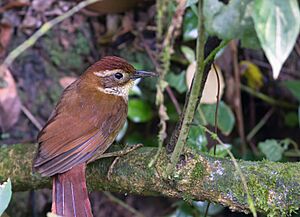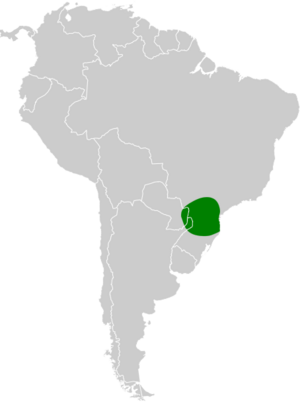Canebrake groundcreeper facts for kids
Quick facts for kids Canebrake groundcreeper |
|
|---|---|
 |
|
| Conservation status | |
| Scientific classification | |
| Genus: |
Clibanornis
|
| Species: |
dendrocolaptoides
|
 |
|
The canebrake groundcreeper (Clibanornis dendrocolaptoides) is a special type of bird. It belongs to the ovenbird family called Furnariidae. You can find this bird in parts of Argentina, Brazil, and Paraguay.
Contents
What is a Canebrake Groundcreeper?
The canebrake groundcreeper is a unique bird. It is the only species in its group (meaning it is monotypic). It is closely related to another bird called the henna-capped foliage-gleaner. Both are part of a larger group of birds known as foliage-gleaners.
How to Spot a Canebrake Groundcreeper
This bird is about 20 to 22 centimeters (8 to 8.7 inches) long. It weighs around 52 to 54 grams (1.8 to 1.9 ounces). It has a fairly straight beak. Male and female canebrake groundcreepers look very similar.
Adult birds have a narrow, grayish stripe above their eye. This stripe gets wider towards the back of their head. Their face is a dull reddish-brown, with dark brown areas near their eyes.
Their head is dark chestnut-brown. Their back and rump are a reddish-brown color. The feathers covering their tail are rufous-brown. Their wing feathers are also rufous-brown. The two middle feathers of their tail are dull rufous-brown. The other tail feathers are a rufous-chestnut color.
The throat of the canebrake groundcreeper is white. It has small blackish spots on the sides. Their chest and belly are a dull grayish color. Their sides are rufous-brown. The feathers under their tail are ochre-brown.
Their eyes are brown. Their beak is black. Their legs and feet can be olive-green or greenish-gray. Young birds have a plain, buff-white throat. Their chest might have faint buff spots. Their belly is usually grayer than adult birds.
Where Canebrake Groundcreepers Live
You can find the canebrake groundcreeper in southeastern Brazil. This includes areas from São Paulo state down to Rio Grande do Sul. It also lives in northeastern Argentina, specifically in Misiones Province.
There are also some older reports of these birds in eastern Paraguay. However, it seems they do not live there permanently.
This bird prefers to live in mountain and tropical lowland evergreen forests. They like hilly areas and the edges of forests. They also live in secondary forests, which are forests that have grown back after being cut down. They often stay near rivers and streams. They like dense bamboo thickets and thick plants along these waterways. They can be found from sea level up to about 1,200 meters (3,900 feet) high.
Canebrake Groundcreeper Habits
How They Move Around
Canebrake groundcreepers usually stay in the same area all year long. They are considered "resident" birds in most of their range. However, in Paraguay, they seem to be just passing through.
What They Eat
We don't know much about what the canebrake groundcreeper eats or how it finds food. They are usually seen in pairs. They search for food in thick plants close to the ground. Scientists believe they eat small bugs and other arthropods. They likely pick these creatures off leaves or the ground.
Raising Their Young
Currently, scientists do not know anything about how canebrake groundcreepers breed.
Their Song
The song of the canebrake groundcreeper is a series of loud, short, sharp "chet" notes. These notes are often mixed with harsh chattering sounds.
Canebrake Groundcreeper Status
The IUCN (International Union for Conservation of Nature) keeps track of how many of these birds there are. In 1988, they thought the canebrake groundcreeper was Threatened. In 2000, it was listed as Vulnerable. By 2004, it was Near Threatened. Since 2022, it has been listed as being of "Least Concern." This means it is not currently at high risk of extinction.
The bird lives in a somewhat limited area. There are an estimated 20,000 to 50,000 adult birds. This number is thought to be going down. The biggest threat to the species is the loss and damage of its Atlantic forest home. However, these birds are often found along forest edges. They can also live in forests that are growing back. They can even survive in small pieces of forest. The good news is that they live in several protected areas.


